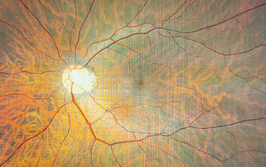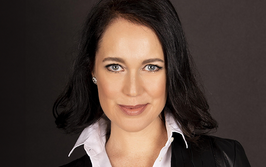
Wait, Treat, Repeat?
A practical guide to managing diabetic macular edema
It is widely known that the global prevalence of diabetes – as well as the complications, deaths, and societal costs associated with it – continue to escalate, with no signs of abating. Unsurprisingly, eye specialists are encountering more patients with diabetic eye disease today than ever before. With diabetic macular edema (DME) remaining a major cause of vision loss, it is essential that all ophthalmologists know how to manage their diabetes patients in the most effective way.
Here are some practical pointers on how to manage DME, based on substantive clinical trial evidence published by the independent body, Diabetic Retinopathy Clinical Research Retina Network (DRCR.net), and key presentations given on the international congress stage.
Start treatment with anti-VEGF therapy
Intravitreal anti-vascular endothelial growth factor (anti-VEGF) therapy is the recommended initial treatment for vision impairment due to DME; it has been shown to provide superior visual and anatomic outcomes compared with laser photocoagulation treatment alone (1, 2, 3, 4). In the DRCR.net Protocol I study, anti-VEGF therapy with prompt laser proved to be no better than anti-VEGF treatment plus deferred laser (2, 3), and as such, laser use should be reserved for those eyes that show no improvement beyond six months of anti-VEGF therapy.
When to consider first-line aflibercept
Intravitreal aflibercept has shown superiority to ranibizumab and bevacizumab over the first and second year of treatment, respectively, in DME eyes with baseline visual acuity (VA) 20/50 or worse (<69 letters) (1, 5, 6), which makes it the anti-VEGF drug of choice in these patients. Though aflibercept, ranibizumab and bevacizumab yield similar gains in vision for patients with 20/32 or 20/40 vision (≥69 letters) at the start of treatment, according to data, at 12 months, those receiving aflibercept are more likely to improve by three or more lines of vision (≥15 letters) from baseline (5). This improvement in vision has been found to be even more pronounced when patients are treated with aflibercept over a two-year period, in comparison with ranibizumab and bevacizumab (6).

Typically begin with six monthly injections
In most DME cases, resolution of edema and VA outcomes continue to improve through six months of consecutive, monthly anti-VEGF injections (2, 5, 7). Patients are unlikely to lose vision if treated intensively at the start and given subsequent injections or focal/grid laser photocoagulation treatments as needed to achieve stability (8).
Choose anti-VEGF over corticosteroids
Given a choice of intravitreal anti-VEGF or corticosteroid treatment, there is stronger data to suggest that more sustained VA improvement can occur with the former. Treatment groups in Protocol I originally managed with laser or triamcinolone plus laser had a gradual improvement in VA after subsequent treatment with ranibizumab, but – whether phakic or pseudophakic at baseline – did not achieve the same long-term vision improvements as those treated with ranibizumab as first-line therapy (9). Cataract removal in the presence of edema does not always lead to meaningful vision improvement (10).
In cases of persistent DME after six monthly anti-VEGF injections, corticosteroids also have limited benefit, especially in phakic eyes. Results from DRCR.net Protocol U show that adding an intravitreal dexamethasone implant to continued ranibizumab treatment in patients with persistent DME does not improve VA at 24 weeks more than continued anti-VEGF therapy alone, although combination corticosteroid and anti-VEGF treatment is more likely to reduce retinal thickness and raise intraocular pressure (11).
Resume anti-VEGF only if central subfield thickness worsens
Regardless of anti-VEGF treatment, meaningful gains in vision with minimal risk of vision loss over two years have been observed in eyes with persistent DME through 24 weeks in Protocol T (Table 1) (8). It is suggested that anti-VEGF treatment is only resumed if there is worsening of central subfield thickness on OCT or VA until stability is achieved.
Follow the DRCR.net retreatment regimen
By observing the DRCR.net approach to anti-VEGF retreatment, most eyes with DME treated with ranibizumab, and either prompt or deferred laser, will maintain the vision gains achieved at one year through five years, with little additional treatment required after three years (3). Sustained vision improvements have been shown to be maintained in the absence of continued treatment unless worsening, with fewer than five injections in years three to five compared with a median of nine injections in the first year of Protocol I. At five years, 56 percent of participants in the deferred laser group in this study did not receive laser.
Vision gains absent at month three? Continue treatment
Eyes showing inadequate response at three months may still go on to experience meaningful vision gains with continued anti-VEGF treatment. Though early visual response to anti-VEGF is associated with good long-term vision outcomes (12), there is substantial individual variability among patients with DME. Limited VA response to anti-VEGF therapy (<5-letter gain from baseline) at week 12 does not preclude further meaningful vision improvement (≥10-letter gain) at two years in many eyes with continued treatment (13). Eyes with limited early VA response have been shown to achieve good vision (20/25 to 20/32) at two years. Changes in central subfield thickness account for only a small proportion of the total variation in changes in VA after anti-VEGF treatment for DME through two years (14).
For DME patients with good vision, observation only may be a good strategy
Sometimes, observation alone is sufficient in DME patients with good vision. In the DRCR.net Protocol V study of DME in eyes with VA 20/25 or better, there was no significant difference in vision loss at two years in eyes initially managed with aflibercept, laser photocoagulation or observation with aflibercept only administered if VA worsened (at least a 5-letter VA decrease from baseline to year two was observed in 16, 17 and 19 percent of eyes in each group, respectively) (15). All three management strategies resulted in a mean VA at two years of 20/20. The proportion of eyes with VA 20/20 or better was significantly greater with aflibercept (77 percent) than observation (66 percent), while the proportion of eyes 20/25 or better was similar in each group (~85 percent).
- U Schmidt-Erfurth et al., “Guidelines for the management of diabetic macular edema by the European Society of Retina Specialists (EURETINA)”, Ophthalmologica, 237, 185 (2017). PMID: 28423385.
- Diabetic Retinopathy Clinical Research Network, MJ Elman et al., “Randomized trial evaluating ranibizumab plus prompt or deferred laser or triamcinolone plus prompt laser for diabetic macular edema”, Ophthalmol., 117, 1064 (2010). PMID: 20427088.
- MJ Elman et al., “Intravitreal ranibizumab for diabetic macular edema with prompt versus deferred laser treatment: 5-year randomized trial results”, Ophthalmol., 122, 375 (2015). PMID: 25439614.
- G Virgili et al., “Anti-vascular endothelial growth factor for diabetic macular oedema: a network meta-analysis”, Cochrane Database Syst Rev, Jun 22, 6:CD007419 (2017). PMID: 28639415.
- Diabetic Retinopathy Clinical Research Network, JA Wells et al., “Aflibercept, bevacizumab, or ranibizumab for diabetic macular edema”, N Engl J Med, 372, 1193 (2015). PMID: 25692915.
- JA Wells et al., “Diabetic Retinopathy Clinical Research Network. Aflibercept, bevacizumab, or ranibizumab for diabetic macular edema: two-year results from a comparative effectiveness randomized clinical trial”, Ophthalmol, 123, 1351 (2016). PMID: 26935357.
- F Ziemssen et al., “Initiation of intravitreal aflibercept injection treatment in patients with diabetic macular edema: a review of VIVID-DME and VISTA-DME data”, Int J Retina Vitreous, 2, 16, eCollection (2016). PMID: 27847634.
- NM Bressler et al., “Persistent macular thickening following intravitreous aflibercept, bevacizumab, or ranibizumab for central-involved diabetic macular edema with vision impairment: a secondary analysis of a randomized clinical trial”, JAMA Ophthalmol, 136, 257 (2018). PMID: 29392288.
- SB Bressler et al., “Five-year outcomes of ranibizumab with prompt or deferred laser versus laser or triamcinolone plus deferred ranibizumab for diabetic macular edema”, Am J Ophthalmol, 164, 57 (2016). PMID: 26802783.
- Diabetic Retinopathy Clinical Research Network Authors/Writing Committee, SB Bressler et al., “Pilot study of individuals with diabetic macular edema undergoing cataract surgery”, JAMA Ophthalmol, 132, 224 (2014). PMID: 24309926.
- RK Maturi et al., “Effect of adding dexamethasone to continued ranibizumab treatment in patients with persistent diabetic macular edema: a DRCR network phase 2 randomized clinical trial”, JAMA Ophthalmol, 136, 29 (2018). PMID: 29127949.
- VH Gonzalez et al., “Early and long-term responses to anti-vascular endothelial growth factor therapy in diabetic macular edema: analysis of Protocol I data”, Am J Ophthalmol, 172, 72 (2016). PMID: 27644589.
- NM Bressler et al., “Early response to anti-vascular endothelial growth factor and two-year outcomes among eyes with diabetic macular edema in Protocol T”, Am J Ophthalmol, 195, 93 (2018). PMID: 30077569.
- NM Bressler et al., “Association between change in visual acuity and change in central subfield thickness during treatment of diabetic macular edema in participants randomized to aflibercept, bevacizumab, or ranibizumab: a post hoc analysis of the Protocol T randomized clinical trial”, JAMA Ophthalmol, Jun 27, doi: 10.1001/jamaophthalmol.2019.1963 (2019). [Epub ahead of print]. PMID: 31246237.
- CW Baker et al., “Effect of initial management with aflibercept vs laser photocoagulation vs observation on vision loss among patients with diabetic macular edema involving the center of the macula and good visual acuity: a randomized clinical trial”, JAMA, Apr 29, doi: 10.1001/jama.2019.5790 (2019). [Epub ahead of print]. PMID: 31037289.
Rod McNeil is an independent medical journalist.













